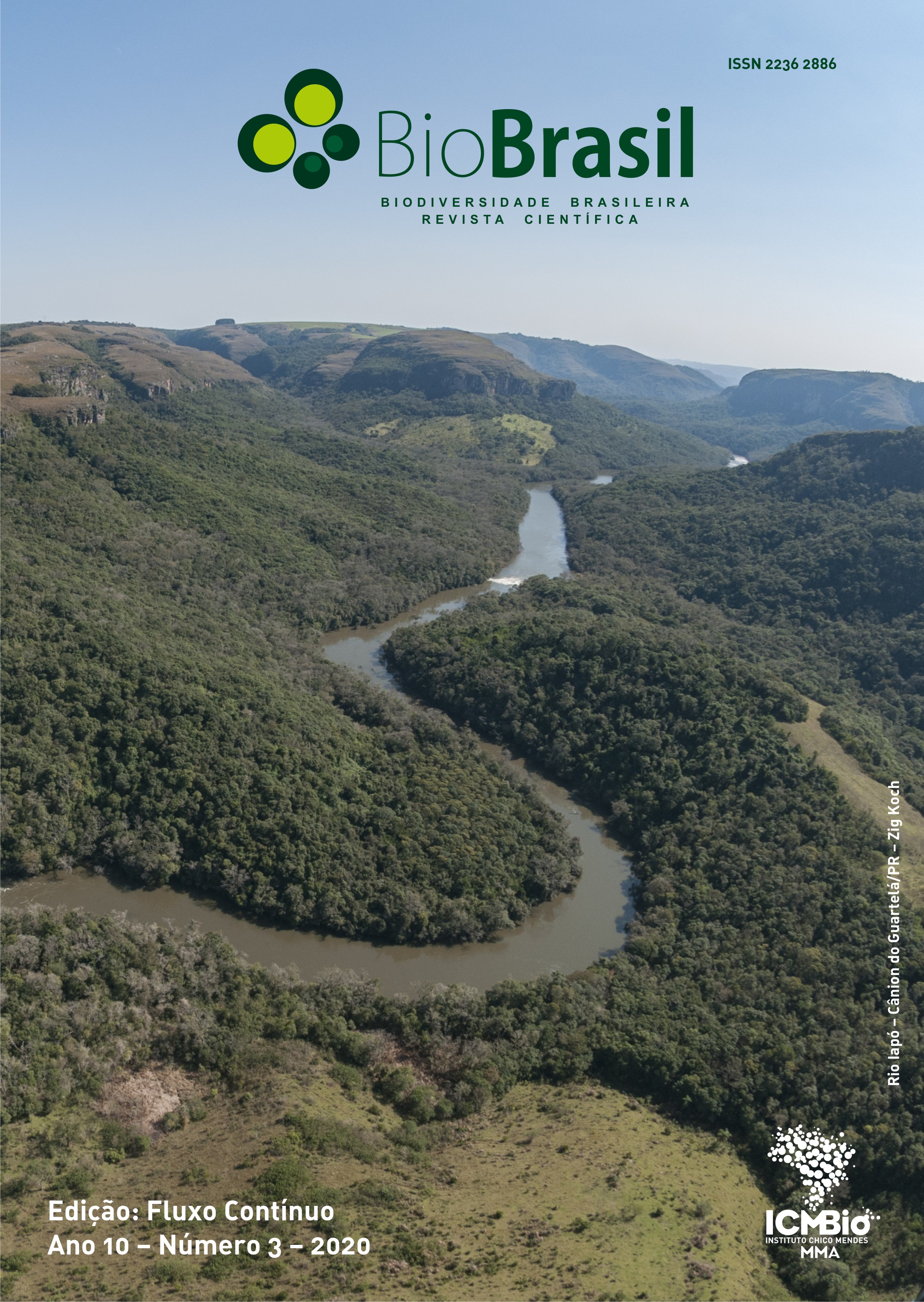Local ecological knowledge (CEL) in assessing the conservation status of species of socioeconomic interest
integrating knowledge in the management of REVIS Ilha dos Lobos
DOI:
https://doi.org/10.37002/biodiversidadebrasileira.v10i3.1639Keywords:
Local ecological knowledge, assessment of conservation status of species, participatory management of protected areas, extinction riskAbstract
The assessment of the conservation status of brazilian fauna, attributed by the Instituto Chico Mendes de Conservação da Biodiversidade (ICMBio), has been an immense and qualified effort, aggregating hundreds of researchers from different institutions. However, in this process, the involvement of the local ecological knowledge (LEK) of species that are caught by users still be a challenge, which tends to enable a greater information framework for the assessment and the expansion of the social and institutional articulation for conservation. These possibilities are also sought for the participative management of Protected Areas, aiming at greater efficiency and effectiveness of their goals in their regions. In this document, we report the application of a methodology that can be useful in these two scopes - in the assessment of the conservation status of the fauna process and in the management of protected areas. Based on the identification, by artisanal fishermen, of 68 aquatic species (among teleosts, elasmobranchs and crustaceans) that occur in the Wildlife Refuge Ilha dos Lobos (REVIS Ilha dos Lobos) region, species that were considered important for fishing were selected, considering estuaries/lagoons and ocean environments (differentiating the regions between the Refuge and the coast and in the open sea). On these species, according to the LEK, the population trend and the main threats were characterized.
Downloads
References
Begossi, A. ; Salivonchyk, S.; Hallwass, G.; Hanazaki, N.; Lopes, P. F. M. ; Silvano, R. A. M. . Threatened fish and fishers along the Brazilian Atlantic Forest Coast. AMBIO , v. 46, p. 907-914, 2017.
Brasil. 1998. Decreto nº 2.519, de 16 de março de 1998. Promulga a Convenção sobre Diversidade Biológica, assinada no Rio de Janeiro, em 05 de junho de 1992. Presidência da República Federativa do Brasil.
Brasil. 2000. Lei 9.985 de 18 de julho de 2000. Sistema Nacional de Unidades de Conservação (SNUC). Presidência da República Federativa do Brasil.
Brasil. 2002. Decreto nº 4340, de 22 de agosto de 2002. Regulamenta artigos da Lei no 9.985, de 18 de julho de 2000. Presidência da República Federativa do Brasil.
Brose, M. (org). 2001. Metodologia participativa: uma introdução a 29 instrumentos. Porto Alegre: Tomo Editorial. 312 p.
Diegues, A. C. (org.). 2000. Etnoconservação: novos rumos para a proteção da natureza nos trópicos. 2ª edição - São Paulo: NUPAUB-USP: Hucitec: Annablume.
Fernandes de Souza, E. C.; Brant, A.; Rangel, C.A.; Barbosa, L.E.; Carvalho, C.E.G. de; Jorge, R.S.P.; Subirá, R.J. Avaliação do risco de extinção da fauna brasileira: ponto de partida para a conservação da biodiversidade. Diversidade e Gestão 2(2): 62-75, 2018.
Geilfus, F. 2002. 80 herramientas para el desarrollo participativo: diagnóstico, planificación, monitoreo, evaluación / Frans Geifus - San José. C.R.: IICA.
Hanazaki, N.; Berkes, F.; Seixas, C. S.; Peroni, N. 2013. Livelihood Diversity, Food Security and Resilience among the Caiçara of Coastal Brazil. Human Ecology , v. 41, p. 153-164.
ICMBio (Instituto Chico Mendes de Conservação da Biodiversidade). 2018. Livro Vermelho da Fauna Brasileira Ameaçada de Extinção: Volume I/1. ed. Brasília: ICMBio, 492 p. (impresso). Acompanha Pen Card contendo: v.2. Mamíferos - v.3. Aves - v.4. Répteis - v.5. Anfíbios - v.6. Peixes - v.7 Invertebrados.
ICMBio (Instituto Chico Mendes de Conservação da Biodiversidade). 2019. Painel dinâmico de informações. Brasilia: ICMBio, 2019. Documento não paginado. Disponível em: <http://qv.icmbio.gov.br/ QvAJAXZfc/opendoc2.htm?document=painel_corporativo_6476. qvw&host =Local&anonymous= true > Acesso em: 15 fev 2019.
Kellermann, A. 2018. Refúgio de Vida Silvestre da Ilha dos Lobos: formação e caracterização do seu conselho gestor. Dissertação. (Mestrado Profissional em Ambiente e Sustentabilidade) - Universidade Estadual do Rio Grande do Sul. São Francisco de Paula. Rio Grande do Sul, p. 92.
Minayo, M. C. de S. (Org). 1994. Pesquisa social: teoria, método e criatividade. Petrópolis, RJ: Vozes, 80 p.
MMA (Ministério do Meio Ambiente). 2014. Portaria MMA nº 43 de 31 de janeiro de 2014. Dispõe sobre a instituição do Programa Nacional de Conservação das Espécies Ameaçadas de Extinção - Pró-Espécies. Disponível: http://www.mma.gov.br/ images/ arquivos/biodiversidade/projetos/ Portaria%20MMA%2043-2014.pdf.
Steenbock, W. & Medeiros, R.P. 2017. Manual de avaliação e monitoramento socioeconômico para a gestão de recifes de coral. Brasília: Instituto Chico Mendes de Conservação da Biodiversidade, 274 p. Traduzido de Bunce, L., P. Townsley, R. Pomeroy and R. Pollnac, 2000. Global Coral Reef Monitoring Network, Australian Inst. Marine Science, Townsville, Australia, 251 p.
Downloads
Published
Issue
Section
License
Copyright (c) 2020 Biodiversidade Brasileira - BioBrasil

This work is licensed under a Creative Commons Attribution-NonCommercial-NoDerivatives 4.0 International License.
Os artigos estão licenciados sob uma licença Creative Commons Atribuição-NãoComercial-SemDerivações 4.0 Internacional (CC BY-NC-ND 4.0). O acesso é livre e gratuito para download e leitura, ou seja, é permitido copiar e redistribuir o material em qualquer mídia ou formato.












